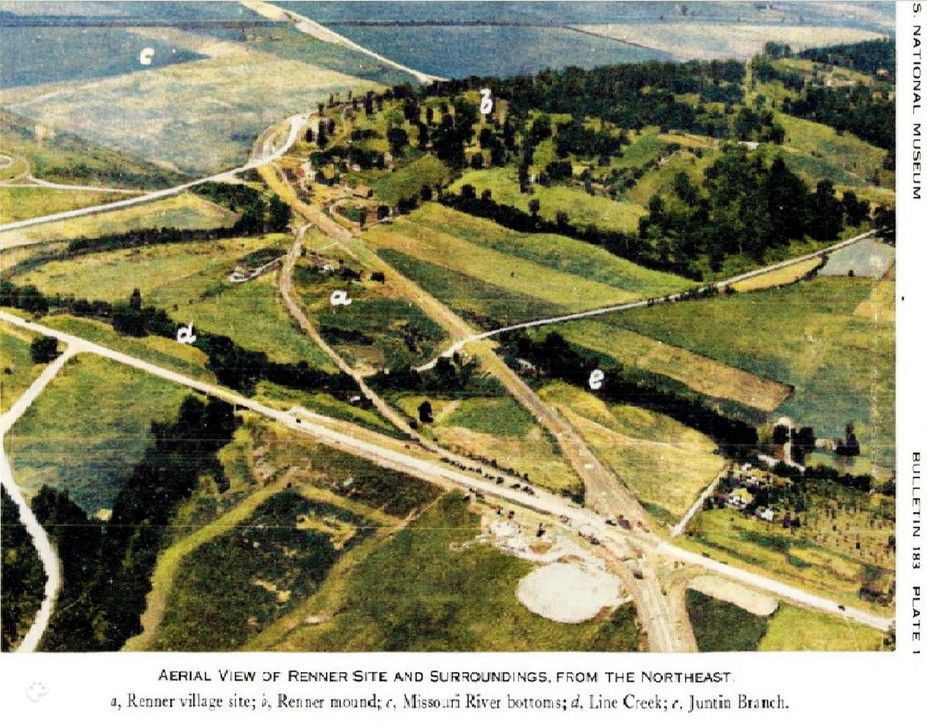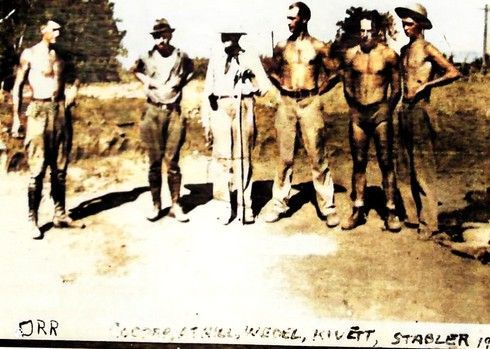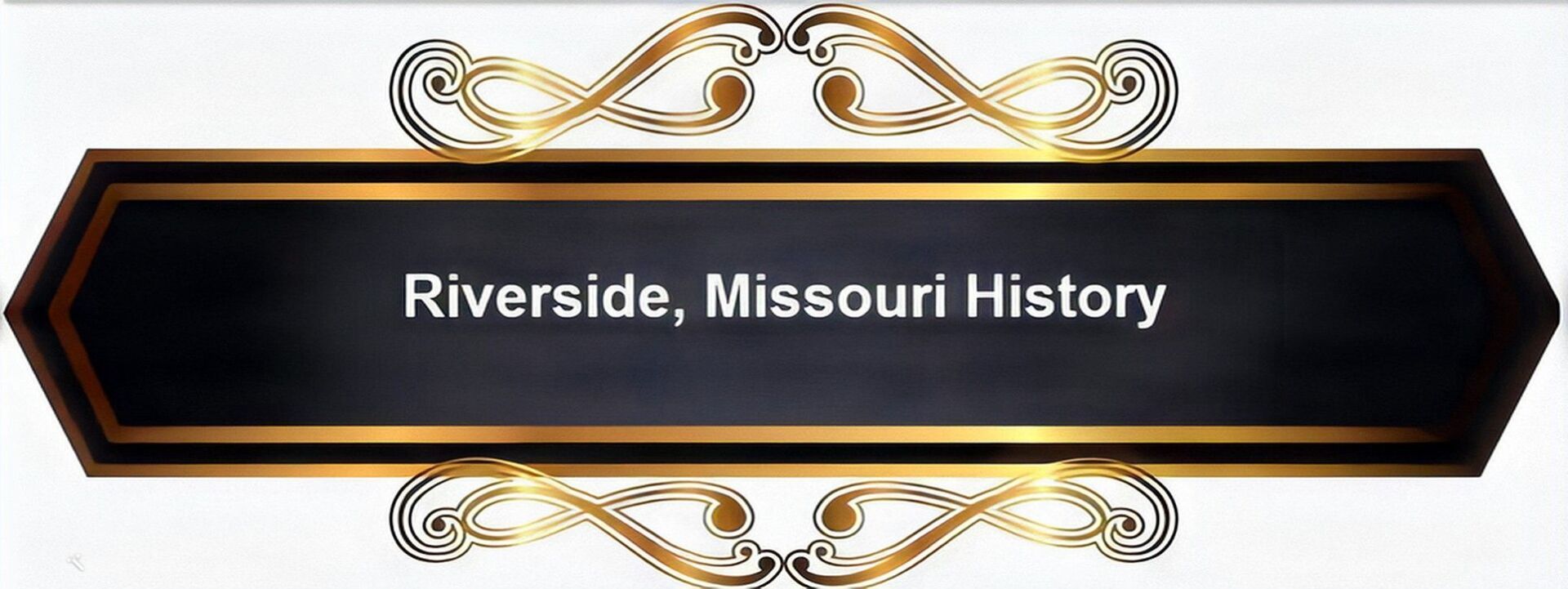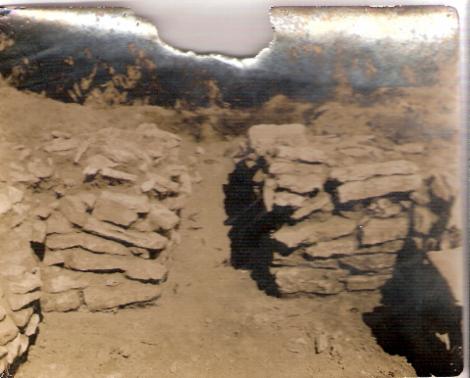RIVERSIDE PREHISTORY
This entire website wouldn't have the room to fill all information known about Riverside history. I've made a fair attempt and giving the highlights as best I can.
A more detailed account of the Renner Brenner Site Park can be seen at the links below.MORE ON THE RENNER SITE IS ALSO UNDER THE 1928-1939 AND THE 1980-1993 PAGES.
THE RENNER-BRENNER SITE PARK LINK IS A MORE EXTENSIVE LINK WITH EXCAVATION AND ARTIFACT PHOTOS.


PREHISTORIC TIMELINE
There are five main prehistoric time period where each has sub periods. Examples of all periods have been found in Riverside.
Paleo 10,000 BC-8,000 BC
Early Archaic 8,000 BC- 4700 BC
Middle Archaic 4700 BC - 3600 BC
Late Archaic 3600 BC - 1550 BC
Early Woodland 1500 BC - 350 BC
Middle Woodland 350 BC - 350 AD KC Hopewell Period
Late Woodland 350 AD - 750 AD KC Hopewell Period
[some argue the more exact date for the KC Hopewell to be 0-400 AD]
Early Mississippian 750 AD - 1100 AD
Middle Mississippian 1100 AD - 1350 AD
Late Mississippian 1350 AD- 1500 AD.
Major Riverside Excavations
Judge West 1877, Lykins 1878, burial mounds in (now known as) Indian Hills
Professor Broadhead 1880, Indian Hills burial mounds
Professor Fowke 1907, Indian Hills burial mounds.
Shippee 1923 personal & discovery, Renner Site,
Shippee 1937 personal along side Wedel, Renner Site.
[Also Shippee, Renner Mound]
Wedel 1937 National Museum (Smithsonian Institute), Renner Site and burial mounds.
Roedl & Howard 1954-1956 University of Missouri, Renner Site
Brenner 1982- 1993 Maple Woods Community College, Renner Site
[Including Dr. Burk's, Park College 1980-82]
SCI 2010 contract archaeologists, Renner Site
[not published as of fall, 2018]
Every human had to have the ability to create fire where that ability varied between cultures. The Hopewell's had advanced where that was no longer a 24 hour a day issue and where free time was born, which meant that had learned to create fire on demand. Previous cultures had to keep a fire constantly going and there had to be a moment in time when they learned they could do this. The Hopewell develop and extensive trade network that wouldn't be excelled for another 1,000 years. They survived long droughts, extremely cold winters and otherwise carried on a way of life that we may never understand how they did it. There was no medicine, no emergency rooms, but modern medicine evolved from our prehistoric past.
The evolution of mankind is separated by the ocean where more advanced people live in Africa and where technology is advanced through distance and time. Egypt was a flourishing community just when the Hopewell's were beginning. The Roman/pyramid phase ended in a failure.
All prehistoric cultures have ended eventually in failure. Our modern culture has not come close in time to what our prehistoric ancestors had accomplished. We would need to survive at least another 1,000 years to even come close.
In 2018, the argument among scholars is if the Hopewell had a spoken language where the argument is if you don't have written language, then you can't speak. Why, because there is no proof.
I can speak to my dog and cat where they understand the basic commands and I've seen my cat and dog talk to each other. We've shown too often in movies of prehistoric people talking with grunts and think they were far beyond the grunt method.

Carolina (Brenner) Renner
Photo taken in 1975 of Carolina on her front porch and her sleeping dog. Carolina was the daughter of John P. Brenner and she married Leslie Renner. After her passing in 1980, part of the property was sold by her estate to the city with the stipulation that a proper marker be posted with the wording to include the names of Brenner and Renner.
In the archaeological community, it is known as the Renner Site with the number 23PL1.
It was the first property in Platte County to be designated to the National Register of Historic Places.
THE RIVERSIDE HOPEWELL
About 500 BC, a group of native Americans formed a collective society in Ohio that we call the Hopewell. Hopewell is not an Indian name. It's from last name of a farmer where the first "Hopewell" artifacts were discovered in Ohio.
The social sphere of the Hopewell expanded outward from Ohio to as far as Florida, Arkansas, New York and nearly all the area in between. In doing this, they set up a trade network that is still difficult to comprehend.
Archaeological evidence shows us the Riverside Hopewell migrated from Ohio to a site in southern Illinois and then from there came to Riverside. All along their way, they established other villages or small camps. We know this primarily from their pottery designs which were identical along this route
Carbon dating tells us the Riverside Hopewell established the Renner Site about 350 AD and stayed there until about 710 AD, where the climax of the site was about 370 AD, or about 1100 years, although carbon dating at Renner has it up to 710 AD.
Within the Hopewell interaction sphere, there were variations of Hopewell. Some were known as the Havana and other's as the KC Hopewell. The different names of the society were due to structure and time differences.
The main Ohio group had large earthworks and more creative effigies out of stone and copper implements, etc.
With the distance away from Ohio, the KC Hopewell only had hints of the Ohio Hopewell, or were the "watered down" versions. The Renner Hopewell lacked the amazing stone pipe and effigy carvings of the Ohio culture. The Ohio culture had amazing earth works of snakes, etc., where the Riverside culture had small mounds and seemed to be merely imitating there Ohio counterparts. Part of this was due to Ohio having upwards of 20,000 people, where Riverside maybe had 100 at any given time. When the main Ohio group vanished or disbanded, the Renner Hopewell were still carrying on not knowing and continued to do so for another 100-200 years.
The Hopewell society is within the Woodland period and is distinct because of developing farming, they had developed free time for the first time in prehistory. They had time to pay games, concentrate on art and probably for the first time, concentrate on bathing and how they looked, etc. The best remains of their artwork are found in pottery decorations where despite the distance between camps, there are basic designs found in every Hopewell sites which help archaeologists understand the time difference.
Evidence from Renner tells us they traded for copper from Wisconsin and obsidian from Wyoming and sconce shells from the Keys. They grew corn, harvested paw paw seeds and a form of lima beans.
They wore clothing and leather shoes. Some clothing was oven. They adorned themselves with special hair do's and ear rings and other jewelry. Some were of copper, most were bone. Some skeleton remains reported by Fowkes in the late 1890's in the current day Indian Hills, reported a red substance on the skull area. Decades later we would learn this was ground hematite which is red and is evidence of makeup.
They created fired clay dolls for the children and domesticated wolves for pets. They created pottery that still can't be duplicated today where some vessels were as large as five gallon buckets and would have had to have been heated to 2,000 degrees for a significant time.
The Hopewell didn't know about the bow and arrow and used a spear with a special handle known as an atlatl. The bow and arrow wasn't introduced until the Mississippian period. Us archaeologists have come up with the time periods and it's important to note in every period the cultures clashed.
There was a day when the late Woodland Hopewell met the early Mississippian aiming a arrow with a bow.
Their main diet was white tailed deer, however every modern wild animal bones have been recovered including bears and fish.
The average lifespan of a Riverside Hopewell was 35. You were probably an "adult" by the age of 12 or 13. You were middle age in your early 20's. Only 1 in 5 of your children will live passed the age of 5 and only half of those will make it to 13.
Yet, they somehow carried on a way of life for over a thousand years!
THE IMPORTANT PART IS ALTHOUGH THE HOPEWELL WAS THE MOST SIGNIFICANT AT RENNER, ARTIFACTS FROM EVERY OTHER CULTURE FOR THE LAST 10,000 YEARS HAVE BEEN FOUND ON THE 5 ACRES OF THE RENNER SITE.
That monument in the park is there for a reason folks. Next time your skating or watching your kids swing, walk over to that monument and think about all that has happened on the spot where your standing and give your respect.
Ancient America: Hopewell
Our American and Canadian heritage begins long before Columbus supposedly “discovered” the Americas. For thousands of years people have lived in North America and they built cities and towns which were, and still are, architectural wonders. About 2,200 years ago, the Indian people living in the Ohio and Mississippi areas began a new cultural complex which archaeologists would later call Hopewell. One of the outstanding characteristics of the Hopewell culture is the earthen mounds. Typical Hopewell mounds are 12 meters high and about 30 meters across at the base. Earthworks, which sometimes exceed 500 meters in diameter, were constructed in circular, square, rectangular, and octagonal shapes.
Hopewell is sometimes called a civilization without cities. The people settled in small farmsteads and hamlets within hailing distance of one another. Their settlements were spread out along the floodplains and terraces or they were loosely clustered in the upland areas.
The size and complexity of the mounds provide insights into Hopewell planning, engineering skills, and social organization. The mounds and other archeological evidence show that Hopewell people had a highly developed social organization that included class structure and a division of labor, with specialists like metal workers, artists, and traders. In addition, they had leaders of hereditary rank and privileges, a strong religious system, and control over cooperative labor.
The Hopewell mounds appear to have been ceremonial centers, places where people were buried. In addition to mortuary ceremonies, they were probably also used for other ceremonies. These ceremonies provided an opportunity for the people living in scattered villages to come together.
A second major characteristic of Hopewell was the flowering of artistic creation at this time. The Hopewell people not only made many useful items, but they made artifacts that were beautiful. They decorated their pottery with both dentate-stamping and rocker-stamping. Their pottery often had cross-hatched rim decorations and zoned decorations.
In addition to pots, the Hopewell people also made pottery figurines, usually depicting humans.
Another characteristic Hopewell artifact was their platform smoking pipes. These pipes were sometimes carved with animal and bird effigies.
For personal decoration, the Hopewell people made pottery rings, ear spools from both copper and stone, and copper headpieces. They often used antlers to indicate chiefly or leadership status.
Another interesting Hopewell artifact is the Hopewell Hand: a hand which was carved from mica and buried in a mound in Ohio.
While it is common to characterize Indian people prior to the arrival of the Europeans as “stone age” people, the Hopewell made many different artifacts from copper. Their copper artifacts included musical instruments such as panpipes, cutting tools such as copper celts, copper needles, and beads made from both copper and from meteoric iron. In addition to working with copper, the Hopewell artists also made some objects from gold and silver.
Like other Indian cultures, the Hopewell were not isolated from the rest of North America. The Hopewell trading network spread west to Yellowstone Park in Wyoming, north to Ontario, Canada, and south to the Gulf of Mexico. Trade goods included copper from the Lake Superior area, mica from the southern Appalachians, obsidian and grizzly bear teeth from Wyoming and Montana, and marine shells from both the Atlantic and Gulf of Mexico. It is clear from the distribution of these goods that some network, either social or religious, must have existed for this exchange to take place.
As evidence of this wide trading network, Hopewell graves in Illinois, Michigan, and Illinois contain such items as conch shells from the Gulf Coast, shark teeth from the ocean, and pipes with alligator effigies.
Hopewell influence stretched from Minnesota in the north to Mississippi in the south, from Nebraska in the west to Virginia in the east. This does not mean that Hopewell was an empire, or even a political confederation of tribes. Rather, Hopewell as probably one of the first Pan-Indian religious movements whose artistic style and ideas influenced many other cultures stretching from Mississippi to Minnesota, from Nebraska to Virginia.
Hopewell influenced the mound-building cultures of the southeast. The Mandeville site in Georgia displays clear evidence for participation in the so Hopewell Interaction Sphere (the area of Hopewell influence). Artifacts at the site which are identified as Hopewell include copper panpipes, copper ear spools, mica, platform pipes, ceramic figurines, galena, and “Flint Ridge” blades.
At Mandeville, the Hopewell tradition was reinterpreted by the local culture. Part of this local reinterpretation of the Hopewell tradition apparently consisted of the construction of small platform mounds for ritual practices.
The Mandeville site was abandoned about 300 CE. At this time there was a decrease in Hopewell influence in the region. The abandonment appears to have been part of a larger shift in settlement in the lower Chattahoochee River Valley.
The mounds and other features show that the Hopewellians had a highly developed social organization. This probably included a class structure and a division of labor, with specialists like metal workers, artists, and traders; leaders of hereditary rank and privileges; a strong religious system; and direction over cooperative labor.
While the Hopewell did raise some corn, this was not their most important food source. They raised a number of indigenous crops, such as sunflowers, marsh elder, squash, little barley, erect knotweed, maygrass, and stumpweed. They also got much of their food from gathering wild plants, from hunting and from fishing. For fishing, they made fishhooks from both copper and bone.
Hopewell villages tended to be located in areas which were good for growing native crops. Usually their settlements were dispersed along stream and river valley corridors. Their villages generally did not appear to have any overall community plan.
While there are no clear connections between Hopewell and contemporary Indian tribes, many of the cultural traditions of the Iroquois tribes seem to be linked to Hopewell. The Iroquois, like the Hopewell, use antlers as the metaphor for chiefly office. Similarly, both groups use a weeping-eye motif in their art.

J. Mett Shippee discovered the Renner site in 1923 while walking to Parkville. The road traveled along the east side of the current park. He made this drawing in 1947 from sketches he made his first sketches. This drawing was for the National Museum now known as the Smithsonian Institute.
This is a 2018 Google Earth view of the Renner Site where the large red circle notes the approximate size of the site which was about 6 acres. The smaller red circle around the old Renner Home (bottom center) shows the home location was a fortified Hopewell home surrounded by a wood fence on that same spot. In 1985, Gary Brenner discovered there were rock lined post holes that surrounded the house about 10 feet apart. Carolina Brenner Renner, who lived there since it was built in 1921 to 1979, said the home was built on the highest part of the otherwise flat land. In Brenner's unpublished Population Studies, he reasoned the site was not so much a village as it was more like a modern day farm and the fortified structure was simply where the permanent family stayed.
Back then, the Missouri River wasn't controlled and migrated and wandered however it wanted. In 1984, Brenner discovered large deposits of sand along the east bluff of the site that indicated the Missouri River was around the east side of the site for several hundred years.


This is an artists painting based on archaeological evidence on how the Renner Site may have looked about 350 AD. Some evidence suggests the homes were smaller and more rounded. All evidence is conclusive they had wattle and daub walls, which is a fancy term for sticks, mud and straw or grass. This drawing is likely closer to how homes looked at the Ohio Hopewell complex, but the fact is we'll never know for sure.

This is probably a more accurate drawing of how it may have looked on the south and east side at the Renner Site where the pottery and buildings are more representative of archaeological evidence. The B&W photo was a the model inside the Line Creek Museum and is also considered very accurate. The museum was removed about 2002.

Since his discovery in 1923, Shippee did a few excavations and fired off several letter to convince Professor Waldo Wedel to come investigate. Wedel finally came in 1937 and spent the summer excavating and exploring. He found these amazing restored pottery vessels. These were found about under the current gazebo in the park. They show significant artwork of the Hopewell-Havana phase. For visual, vessels A and B were about the size of a modern 5 gallon bucket.
And below are spear points recovered by Wedel in 1937. (photo is reversed)


Not all projectile points were of flint. This is a photo of a deer antler tine that had been carved into a spear point. It was designed to go in and not come out. It was Recovered by Gary Brenner in 1984 and it's date is estimated at 350 AD.

This is a baked clay human effigy also recovered by Brenner in 1984, which is about 3" tall. It was made without arms and not head or legs were found. It does show us a pot belly male. The make left an intentional thumb print clearly visible under the arm pit area.
From Professor Wedel's report on his investigation in 1937. You are looking southwest. "A" is the Renner-Brenner Site Park. "B" is is now an apartment complex. "C"- far upper left is now Argosy Casino. "D" is Line Creek before the levee project changed it's location. "E" is the Juntin Branch creek which basically comes from Houston Lake. Between A and D we see a road that was known as the Road To Parkville. In this photo we see Vivion Road still under construction. Below E at the under the junction, you see a white circle which was then a baseball field. Today, it is the Corner Cafe.

Again from Wedel, 1937. Photo A is not marked correctly. This is looking northwesterly. What appears to be a creek on the left is a road that you can somewhat make out in the photo above. The house in the center is the KC Airwaves house where Wedel and his crew stayed. The hint of a house behind airwaves is the Renner home and the Renner Site. The bottom two photos are Wedel's excavations in the chicken yard at the Renner house.

Wedel's map of the size of the Renner Site in 1937. North is right to left. 71 Highway is now Gateway. US 169 is now Vivion Road. About where the letter "S" is on the word site, is the current city hall. Where it says, "poultry run" was the chicken yard where Wedel was allowed to investigate. The other house in the upper right center was the KC Airwaves building that years later would be known until the flood of 93 as the Galetti house. Wedel also says there were no prior reports of findings, even though he wouldn't been there if it wasn't for Mett Shippee--which, later he did give him credit for.

Wedel and his team stayed in this house which was just south of the Renner Site. In the 1960's until the flood of 93, it was known as the Pat Galetti house.

A photo of a page of Wedel's artifact catalog from Renner.

Wedel and his team at the Renner site. Dr. Wedel is center.

1937 Map of Wedel's excavations. The trench was centered along the east side of the chicken yard. Today (2018), this is marked by large trees in front of the gazebo where if you look close enough, you can see the stress marks on the trees where the chicken fence was once stapled to.

This is a map of all the known excavations. For reference the blue area is the current playground. The monument is top center. Shippee's original excavation is marked 1921.

Fragments of a prehistoric native American skeleton from Indian Hills. Provided by Joseph Vandepopulaire.

This is a cheesy and corny movie I made in 1990 with actual movie film and is about my thoughts on the last prehistoric person at the site. The best part isn't the story in the movie, it's the fact it was completely filmed at the Renner Site before it was a park where you can see how it looked.
On a 12" ruler of occupation at the Renner Site, modern occupation is less than 5/8" of in inch!!








